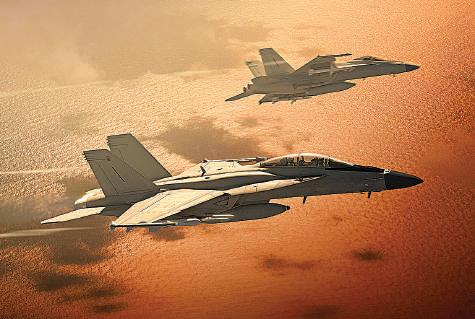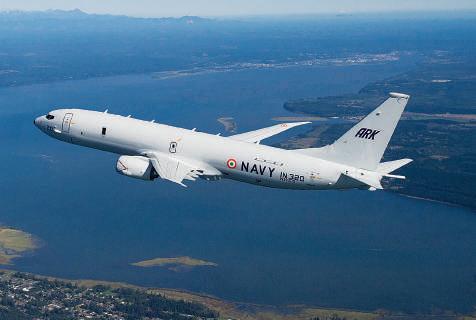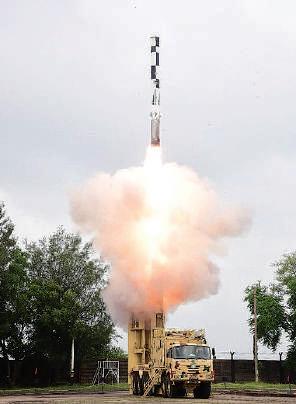
8 minute read
interview michael Koch, vice president, boeing defence, india


Advertisement
(left)f/A-18 Block III Super Hornet; (rIgHt)p-8I of tHe IndIAn nAvy
In conversation with Michael Koch, Vice President, Boeing Defence, Space & Security, India
SP’s ShowNews (SP’s): Boeing has strengthened its defence business in India with many of its iconic platforms servicing the Indian armed forces. How do you see the Indian market growing from your perspective?
Michael Koch (Koch): India’s defence sector is poised for growth and Boeing is committed to supporting and enabling this progress. Boeing has had a presence in the country for over 75 years now, and we’ve had many firsts with India. India was the first international customer for the P-8, is the largest international operator of C-17s and P-8s, and the Harpoon missile was the first US weapon system on an Indian-built fighter.
The future looks promising and we continue to see several opportunities in India. We’re engaged with our defence customers on their requirements for the Indian Air Force’s Multi-Role Fighter Aircraft and the Indian Navy’s Carrier-Borne Fighter programme. Early last year, the Ministry of Defence signed the contract for the acquisition of an additional six Apaches for the Indian Army.
Today, with 11 C-17s, nine P-8Is with three more on order, 22 AH-64 Apaches with six more on order with the Indian Army, and 15 CH-47 Chinooks, India is at the front and center of Boeing’s business plans.
We’re also seeing the growth in our localisation of MRO services and training, and the value Boeing Defence India, our local establishment in India, is able to provide through the lifecycle of Boeing products. We work with the Indian Air Force and the Indian Navy to provide exceptional operational capability and readiness to the P-8Is, C-17s, and Head of State aircraft through local sustainment services in India. Boeing is also providing pilot training for the Indian Air Force fleet of the C-17 aircraft; and we are in the process of providing training to Indian Navy pilots on the P-8I.
We’re contributing to the growth of India’s aerospace industry; that’s why we’re investing in partnerships across the ecosystem in skilling, research & technology, and manufacturing. India’s role in our global supply chain is big and getting bigger. Our commitment to India is deep and it’s for the long term; our vision is to bring the best of Boeing to India and export the best of India to the world.
SP’s: Boeing recently announced the results of the ski jump trials of the F/A-18 Block III Super Hornet. Are there any updates on your talks with Indian Navy for their fighter requirements?
Koch: Boeing and the US Navy recently proved that the F/A-18 Super Hornet can operate from a ski jump, thereby demonstrating the aircraft’s ability to operate on Indian Navy carriers.
We are engaging with the Indian Navy and have responded to the Request for Information for the Multi-role Carrier Borne Fighter (MRCBF) programme. This is a very exciting opportunity to partner with both the Indian Navy and the US Navy. The F/A-18 Super Hornet is the frontline carrier-based fighter of the US Navy, and will not only provide superior war fighting capability but also create opportunities for cooperation in naval security and aviation between the United States and India. The aircraft will be an incredible tool to ensure security and safety in the Indo Pacific region for decades to come.
SP’s: Why do you believe the Super Hornet will meet the Indian Navy’s requirements for a carrier borne fighter?
Koch: It is important to understand that apart from being the most lethal, advanced and combat-proven aircraft, there would be benefits from the incredible know-how and technology investments made by the US Navy related to aircraft carriers and fighter operations at sea. As a strategic partner for security, US Navy is leaning in to provide the best solution available for Indian Navy. This includes the F/A-18 Block III Super Hornet, but it also includes deep capabilities in sustainment, logistics, flight ops, carrier and network integration, etc. These machines are powerful on their own, but they are far more potent when they are part of a fully integrated network of capabilities.
The Super Hornet was designed for the carrier deck and benefits from decades of experience Boeing and US Navy had operating classic Hornets. The Indian Navy would receive the benefit of US Navy’s multi-billion dollar investments in Block III technologies, including advanced networks, longer-range detection with Infrared Search & Track, an all-new Advanced Cockpit System, improved signature reduction and a 10,000+ hour life. The F/A-18 Block III Super Hornet will be a game changer for the Indian Navy providing them several unique and differentiated capabilities.
Another important operationally relevant distinction is that the Super Hornet would prove a force multiplier for the Indian Navy through enhanced networked warfare with other US origin assets that the Indian Navy and the Indian Air Force have, or are in the process of acquiring. The F/A-18 Super Hornets can optimally interface with the P-8I, augmenting lethality of these platforms and enhancing India’s force projection capabilities.
As part of Boeing’s “for India, by India” philosophy, the Block III Super Hornets can be serviced in partnership with the Indian Navy, US Navy and industrial partners from India and the US throughout the lifecycle of the aircraft. This will further develop advanced expertise in aircraft MRO in India, resulting in higher availability of the aircraft at competitive pricing. All these together, with the fact that the Super Hornet is the most affordable tactical fighter in its class ‘per flight hour’ differentiates Boeing’s F/A-18 Block III Super Hornet offer for the Indian Navy.
SP’s: P-8I has always proven its capabilities and has been a strong pillar for Indian Navy when it comes to maritime security. There are three more to be delivered? Any update on the remaining P-8I delivery and your future plans for P-8I fleet?
Koch: In November, last year, Boeing delivered the ninth P-8I to the Indian Navy. This was the first of the four options aircraft, with the remaining three scheduled for delivery this year. The Indian Navy was the first and is the largest international customer for the P-8. This aircraft is an integral part of the Indian Navy’s fleet and is approaching an impressive milestone of 30,000 flight hours since induction in 2013.
Our focus has been, and will continue to be, delivering the world’s best maritime patrol aircraft to the Indian Navy. We’ve been supporting India’s growing P-8I fleet by providing spares, ground support equipment and field service support. Boeing’s logistics support has enabled the highest state of fleet-readiness at the best possible cost. Boeing is currently completing construction on a Training Support & Data Handling (TSDH) Centre at INS Rajali, Arakkonam, in Tamil Nadu, and a secondary centre at Naval Institute of Aeronautical Technology, Kochi, as part of a training and support package contract signed in 2019. The localised, ground-based training will allow the Indian Navy crew to increase mission proficiency in a shorter time, while reducing the on-aircraft training time resulting in increased aircraft availability for mission tasking.
spEcIal REpORT
WOrld’s deadliest cruise missile brahmOs shines at aerO india 2021
BrahMos – reckoned as world’s fastest, deadliest cruise Block III variants – each having its own distinct potentiality missile – is one of the major attractions at Aero In- to hit and destroy high value enemy targets. dia 2021. Designed and developed by India-Russia BrahMos Air-Launched System: The BrahMos airJoint Venture (JV) entity BrahMos Aerospace, the super- borne weapon has given the Indian Air Force (IAF) a distinct sonic weapon with precision strike power is bedazzling the capability to completely knock down strategic enemy assets crowds yet again. on the ground or sea from large, stand-off ranges with deadly
The highly versatile BrahMos weapon system comes accuracy. The advanced air-launched cruise missile (ALCM) with a lethal trident-like combination of speed, precision, can operate in day-and-night, all-weather conditions. After and power. It has emerged as the “ultimate game-changer” undergoing a series of successful launches from the IAF’s for India. Operationalised in the Indian Army, Navy and Air Su-30 MKI air combat platform, BrahMos-A has been sucForce, BrahMos has established itself as a major force mul- cessfully inducted in the IAF’s Tigersharks Squadron in 2020. tiplier in modern-day complex battlefields having impec- BrahMos Ship-based System: The naval strike varicable land-attack and anti-ship capabilities from multiple ant of BrahMos is operational on all frontline destroyers platforms for multi-role missions. and frigates of Indian Navy. The missile can be fired from
The “stealthy killer” straight away annihilates its target vertical and inclined launchers against both land and seaat a maximum velocity of Mach 2.8 after cruising at altitudes surface targets. It can also be launched in ‘salvo’ mode to varying from as low as 10-metres to up to 15-km. BrahMos destroy targets in same or different directions. The weapon can be fitted in ships, mobile autonomous launchers, sub- has also been successfully tested from an underwater platmarines and aircraft to precisely neutralise land and sea- form in 2013, establishing its capability to be fitted onto surface targets. submarines in future.
BrahMos Aerospace, the JV entity between India’s BrAHMoS MISSIle Futuristic BrahMos Versions: Traversing the world of DRDO and Russia’s NPOM, is exhibiting the air, land and futuristic weapon systems, BrahMos Aerospace has initisea variants of the powerful weapon system at the biennial event, pegged to be ated work on a hypersonic BrahMos version. This highly advanced variant would Asia’s premier air show. BrahMos has given a major fillip to India’s “Atmanirbhar be a quantum leap in modern missile technology as it would be developed to Bharat” programme by rendering an unmatched potential to the Indian Armed cruise at an ultra high speed of up to Mach 8. Yet another futuristic variant will be Forces to vanquish any enemy in high intensity, modern conflict situations. BrahMos-NG (next-gen), having smaller, smarter dimensions.
BrahMos Land-based System: The Indian Army has become the first and BrahMos Aerospace is also exhibiting various indigenously developed compoonly army in the world to have a regiment of supersonic cruise missiles with nents and systems at the mega event. Also exhibited are a full-scale BrahMos airborne advanced capabilities. The mobile land-based configuration of BrahMos has weapon integrated on the Su-30 MKI fighter aircraft at the outdoor display alongside achieved several advancements over the years in the form of Block I, Block II and the actual Mobile Autonomous Launcher with 3-BrahMos missile configuration.








